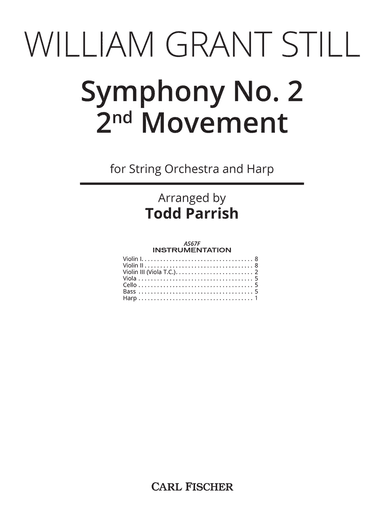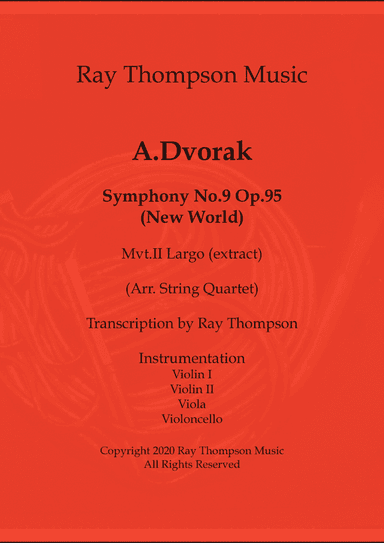Unavailable
Symphony No. 2 - 2nd Mvt is currently unavailable
We can no longer provide this arrangement through Sheet Music Stores. The listing stays online so you can learn about the piece and explore alternatives.
Try these next steps
- Discover similar sheet music curated for you below.
- Search for “Symphony No. 2 - 2nd Mvt” across our catalog.
About this arrangement
Orchestra Cello, Contrabass, Harp, Viola, Violin 1, Violin 2, Violin 3 SKU: CF.AS144 Composed by William Grant Still. Arranged by Todd Parrish. Set of Score and Parts. 10+2+24+16+10+10+16 pages. Carl Fischer Music #AS144. Published by Carl Fischer Music (CF.AS144). ISBN 9781491160602. UPC: 680160919192.Often referred to as the "Dean of African American Composers", William Grant Still's illustrious career contained many ground-breaking achievements. Following the massive success of his critically acclaimed Symphony No. 1, the "Afro-American " Symphony (1930), Still's Symphony No. 2 was premiered in 1937 by the Philadelphia Orchestra under the direction of conductor Leopold Stokowski. The work, subtitled "Song of a New Race", infuses elements of blues and jazz into the classical form, creating a uniquely blended sound to reflect Still's vision of an increasingly diverse American culture. Slow, dreamy themes are expressed through lush harmonies utilizing thick textures along with solo and divisi playing. The tension between traditional and jazz idioms is felt in the push and pull of shifting tempo and tonality. Originally composed for Full Orchestra, this slightly abridged version for String Orchestra includes the original harp part, honoring the legacy of one of America's greatest composers.Often referred to as the "Dean of African American Composers", William Grant Still's illustrious career contained many ground-breaking achievements. Following the massive success of his critically acclaimed Symphony No. 1, the "Afro-American" Symphony (1930), Still's Symphony No. 2 was premiered in 1937 by the Philadelphia Orchestra under the direction of conductor Leopold Stokowski. The work, subtitled "Song of a New Race", infuses elements of blues and jazz into the classical form, creating a uniquely blended sound to reflect Still's vision of an increasingly diverse American culture. Slow, dreamy themes are expressed through lush harmonies utilizing thick textures along with solo and divisi playing. The tension between traditional and jazz idioms is felt in the push and pull of shifting tempo and tonality. Originally composed for Full Orchestra, this slightly abridged version for String Orchestra includes the original harp part, honoring the legacy of one of America's greatest composers.Often referred to as the "Dean of African American Composers", William Grant Still's illustrious career contained many ground-breaking achievements. Following the massive success of his critically acclaimed Symphony No. 1, the "Afro-American" Symphony (1930), Still's Symphony No. 2 was premiered in 1937 by the Philadelphia Orchestra under the direction of conductor Leopold Stokowski. The work, subtitled "Song of a New Race", infuses elements of blues and jazz into the classical form, creating a uniquely blended sound to reflect Still's vision of an increasingly diverse American culture. Slow, dreamy themes are expressed through lush harmonies utilizing thick textures along with solo and divisi playing. The tension between traditional and jazz idioms is felt in the push and pull of shifting tempo and tonality. Originally composed for full orchestra, this slightly abridged version for string orchestra includes the original harp part, honoring the legacy of one of America's greatest composers.Often referred to as the “Dean of African American Composers”, William Grant Still’s illustrious career contained many ground-breaking achievements. Following the massive success of his critically acclaimedSymphony No. 1, the "Afro-American" Symphony (1930), Still’s Symphony No. 2 was premiered in 1937 by the Philadelphia Orchestra under the direction of conductor Leopold Stokowski. The work, subtitled “Song of a New Race”, infuses elements of blues and jazz into the classical form, creating a uniquely blended sound to reflect Still’s vision of an increasingly diverse American culture. Slow, dreamy themes are expressed through lush harmonies utilizing thick textures along with solo and divisi playing. The tension between traditional and jazz idioms is felt in the push and pull of shifting tempo and tonality. Originally composed for full orchestra, this slightly abridged version for string orchestra includes the original harppart, honoring the legacy of one of America’s greatest composers.
Related sheet music

Symphony No. 2 - 2nd Mvt
william grant still

Mozart: Divertimento No.8 in F K213 - wind quintet
wolfgang amadeus mozart, ray thompson

Schubert: Wind Octet in F major, D.72 (Complete) - wind octet
ray thompson

Dvorak: Largo (extract) from Symphony No.9 (New World) Op.95 - string quartet
antonin dvorak, ray thompson

Dvorak: String Quartet No.12 in F Op.96 " American" Mvt.II Lento - symphonic wind dectet/bass
antonin dvorak, ray thompson

The Boosey & Hawkes Piano Solo Collection: Rachmaninoff
sergei rachmaninoff

Variations on an Original Theme for Orchestra op. 36 'Enigma'
edward elgar

Symphony No 2 2nd Mvt Orig Vers Ga-Ce Op. 19
karol szymanowski

The Symphony
various

Classical Arrangements for Bass Guitar
various

Symphony No. 7, Mvt. 2
ludwig van beethoven

Symphony No. 7, Mvt. 2
ludwig van beethoven